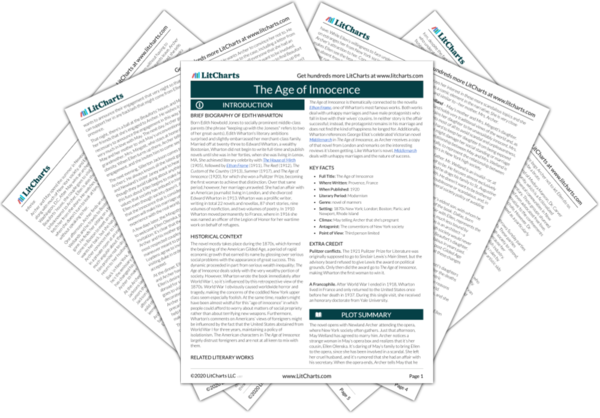Welcome to the LitCharts study guide on Edith Wharton's The Age of Innocence. Created by the original team behind SparkNotes, LitCharts are the world's best literature guides.
The Age of Innocence: Introduction
A concise biography of Edith Wharton plus historical and literary context for The Age of Innocence.
The Age of Innocence: Plot Summary
A quick-reference summary: The Age of Innocence on a single page.
The Age of Innocence: Detailed Summary & Analysis
In-depth summary and analysis of every chapter of The Age of Innocence. Visual theme-tracking, too.
The Age of Innocence: Themes
Explanations, analysis, and visualizations of The Age of Innocence's themes.
The Age of Innocence: Quotes
The Age of Innocence's important quotes, sortable by theme, character, or chapter.
The Age of Innocence: Characters
Description, analysis, and timelines for The Age of Innocence's characters.
The Age of Innocence: Symbols
Explanations of The Age of Innocence's symbols, and tracking of where they appear.
The Age of Innocence: Literary Devices
The Age of Innocence's key literary devices explained and sortable by chapter.
The Age of Innocence: Theme Wheel
An interactive data visualization of The Age of Innocence's plot and themes.
Brief Biography of Edith Wharton
Born Edith Newbold Jones to socially prominent middle-class parents (the phrase "keeping up with the Joneses" refers to two of her great-aunts), Edith Wharton's literary ambitions surprised and slightly embarrassed her merchant-class family. Married off at twenty-three to Edward Wharton, a wealthy Bostonian, Wharton did not begin to write full-time and publish novels until she was in her forties, when she was living in Lenox, MA. She achieved literary celebrity with The House of Mirth (1905), followed by Ethan Frome (1911), The Reef (1912), The Custom of the Country (1913), Summer (1917), and The Age of Innocence (1920), for which she won a Pulitzer Prize, becoming the first woman to achieve that distinction. Over that same period, however, her marriage unraveled. She had an affair with an American journalist living in London, and she divorced Edward Wharton in 1913. Wharton was a prolific writer, writing in total 22 novels and novellas, 87 short stories, nine volumes of nonfiction, and two volumes of poetry. In 1910 Wharton moved permanently to France, where in 1916 she was named an officer of the Legion of Honor for her wartime work on behalf of refugees.
Get the entire The Age of Innocence LitChart as a printable PDF.

Historical Context of The Age of Innocence
The novel mostly takes place during the 1870s, which formed the beginning of the American Gilded Age, a period of rapid economic growth that earned its name by glossing over serious social problems with the appearance of great success. This dynamic proceeded in part from serious wealth inequality; The Age of Innocence deals solely with the very wealthy portion of society. However, Wharton wrote the book immediately after World War I, so it’s influenced by this retrospective view of the 1870s. World War I obviously caused worldwide horror and tragedy, making the concerns of the coddled New York upper class seem especially foolish. At the same time, readers might have been almost wistful for this “age of innocence” in which people could afford to worry about matters of social propriety rather than about terrifying new weapons. Furthermore, Wharton’s comments on Americans’ views of foreigners might be influenced by the fact that the United States abstained from World War I for three years, maintaining a policy of isolationism. The American characters in The Age of Innocence largely distrust foreigners and are not at all keen to mix with them.
Other Books Related to The Age of Innocence
The Age of Innocence is thematically connected to the novella Ethan Frome, one of Wharton’s most famous works. Both works deal with unhappy marriages and have male protagonists who fall in love with their wives’ cousins. In neither story is the affair successful; instead, the protagonist remains in his marriage and does not find the kind of happiness he longed for. Additionally, Wharton references George Eliot’s celebrated Victorian novel Middlemarch in The Age of Innocence, as Archer receives a copy of that novel from London and remarks on the interesting reviews it’s been getting. Like Wharton’s novel, Middlemarch deals with unhappy marriages and the nature of success.
Key Facts about The Age of Innocence
- Full Title: The Age of Innocence
- Where Written: Provence, France
- When Published: 1920
- Literary Period: Modernism
- Genre: novel of manners
- Setting: 1870s New York; London; Boston; Paris; and Newport, Rhode Island
- Climax: May telling Archer that she’s pregnant
- Antagonist: The conventions of New York society
- Point of View: Third person limited
Extra Credit for The Age of Innocence
Pulitzer conflicts. The 1921 Pulitzer Prize for Literature was originally supposed to go to Sinclair Lewis’s Main Street, but the advisory board refused to give Lewis the award on political grounds. Only then did the award go to The Age of Innocence, making Wharton the first woman to win it.
A Francophile. After World War I ended in 1918, Wharton lived in France and only returned to the United States once before her death in 1937. During this single visit, she received an honorary doctorate from Yale University.












